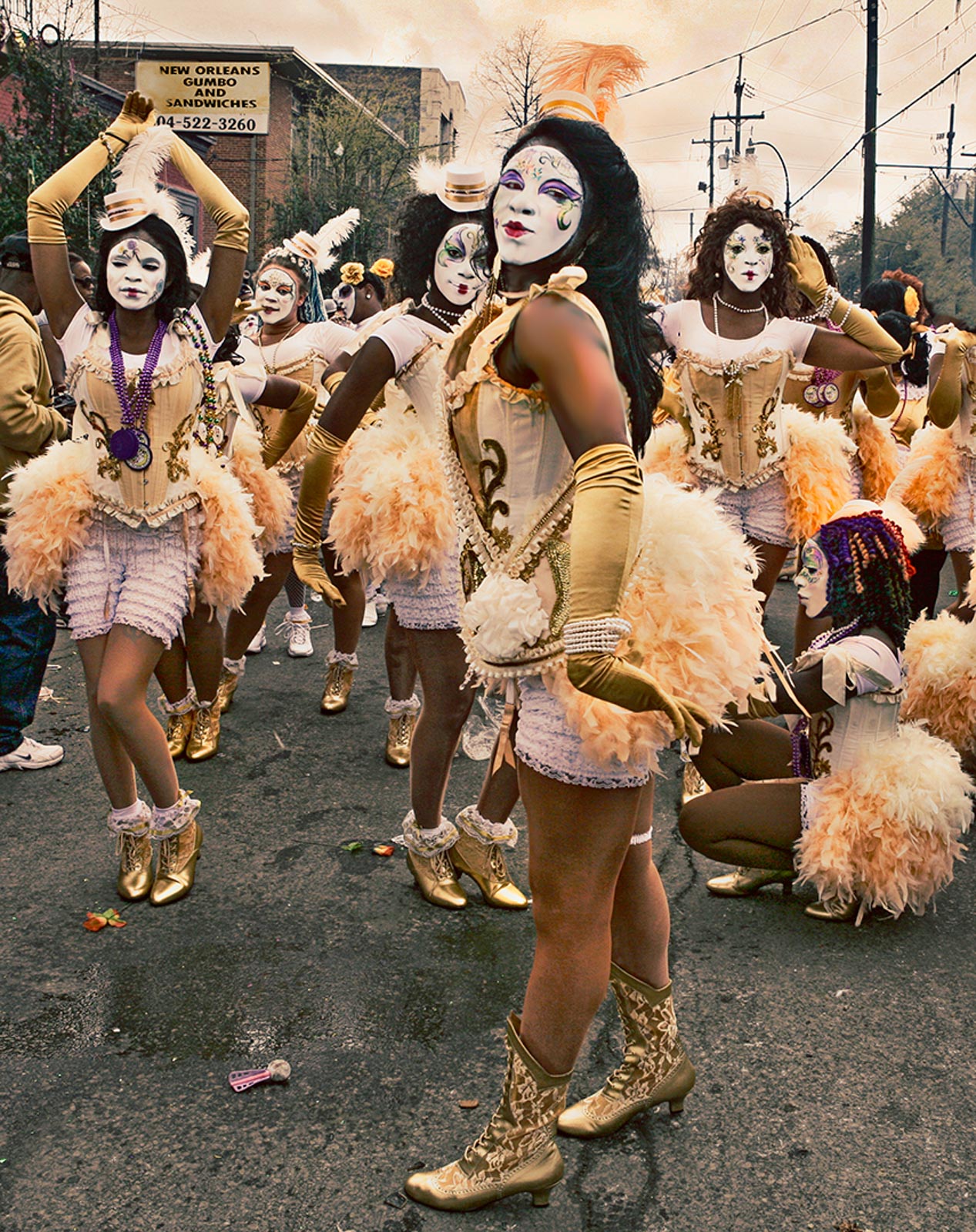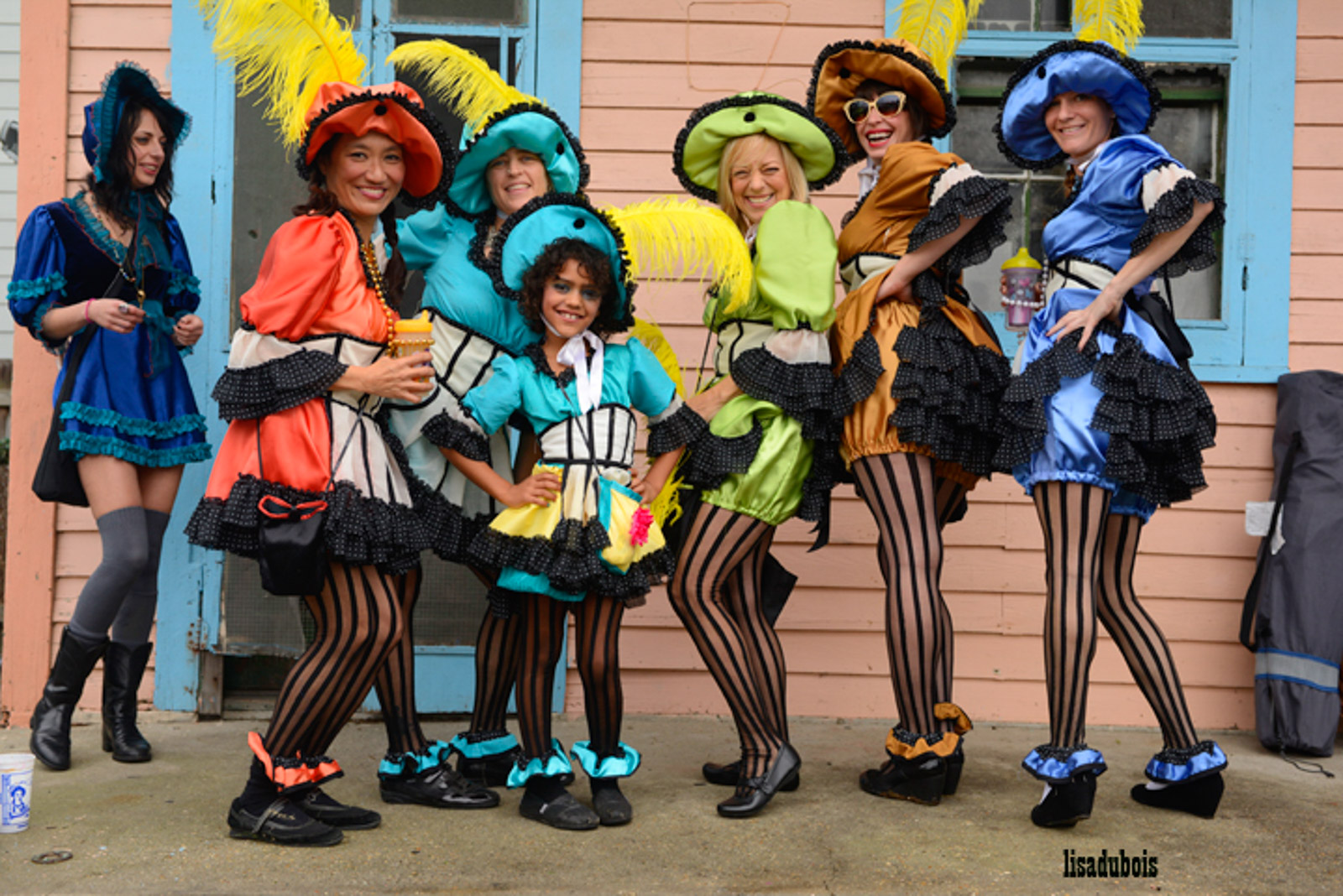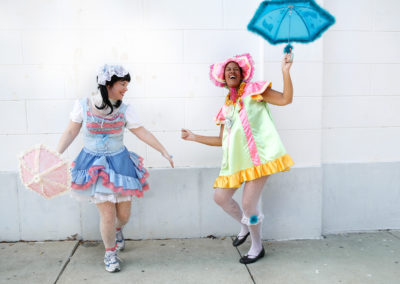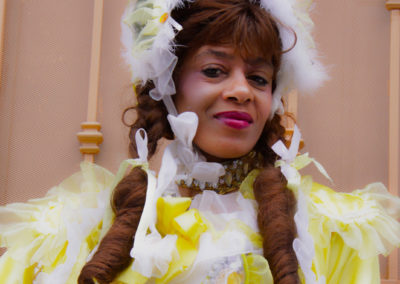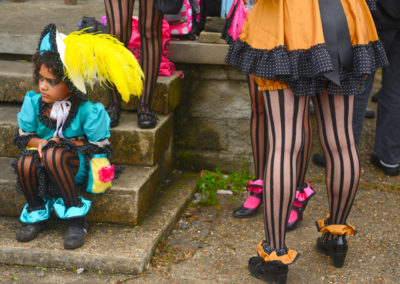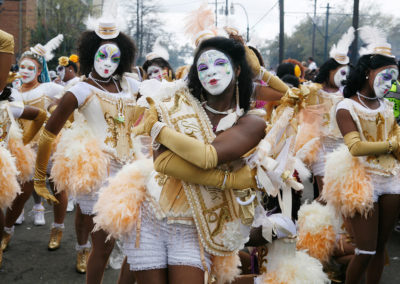The early Baby Dolls had a risqué reputation but eventually came to be seen as trailblazers — claiming public space to express their “raddy” style and giving the back of their hand to hypocritical gender conventions. Today, they’re renowned for their titillating, finely crafted outfits and infectious joie de vivre — and for sustaining an iconic tradition that has been uplifting and empowering women for more than a century.
Cultural-preservationist “she-roes”
In New Orleans, “baby dolling” is not to be confused with playing with toy dolls. Rather, it’s an African American “masking” practice — a live art form — in which females of all ages dress up as Baby Dolls and strut their stuff on Mardi Gras, the feast of St. Joseph and Super Sunday. They also appear at jazz funerals, music gigs, senior citizen homes and various community functions.
In a culture that cherishes expressive arts, their frilly, finely crafted outfits alone would be enough to earn them celebrity status. But the Baby Dolls of New Orleans are also renowned for their infectious joie de vivre and for sustaining an iconic tradition that has been uplifting and empowering women for more than a century.
Melissia White’s Baby Doll Ladies in the 2012 Zulu parade
The combination of the ensemble’s dancing, attire and face paint make for a showstopper.
Photo by Lisa DuBois
Woven into the social and pleasure club fabric of the city, they typically band together in groups and come out with new, coordinated costumes annually. Some groups represent neighborhoods. Some take their names from baby-dollers of yore or might be affiliated with a Black Indian tribe. “Renegade” Baby Dolls mask solo or have shifting affiliations.
How exactly baby dolling got started is contested, according to scholar Kim Vaz-Deville, author of The “Baby Dolls”: Breaking the Race and Gender Barriers of the New Orleans Mardi Gras Tradition (2013), and editor of an anthology, Walking Raddy: The Baby Dolls of New Orleans (2018). One narrative focuses on “sportin’” women in the 1910s who worked as prostitutes and saloon dancers in the red-light district catering to African Americans – so-called Black Storyville, a few blocks from the city’s “official” epicenter of vice (nicknamed Storyville but known to locals as “the District”). Some credit “old Creole ladies” — moms who made baby dolling a family affair in the Seventh Ward and the Tremé, a section of the Sixth Ward bordering the French Quarter. Some say that, in the early days, only men masked as Baby Dolls.
The Million Dollar Baby Dolls from Black Storyville first appeared on Mardi Gras 1912, marking a milestone in the long history of women availing themselves of the license afforded by the holiday to flout societal conventions and express sensuality. Dressed like innocent little girls, in short skirts and bonnets, each of the 30 or so women of color who participated is said to have had at least $50 in bills stuffed in garters that held up their stockings. They took to the streets as if they owned them and made quite a scene — flinging bills, puffing cigars, singing bawdy lyrics and generally throwing down with abandon. They played rough. Untoward advances could result in bodily harm.
At work, pimps and johns called them “baby dolls” – hence their adopted name, which also spoke to their financial wherewithal and independence. Black Storyville was on the uptown side of Canal Street, and the District was on the downtown side. Beatrice Hill, by her own account, conceived of the Million Dollar Baby Dolls to challenge and upstage rivals on their own turf. Venturing downtown, she later recalled in an interview with Robert J. McKinney, “we showed them [women] how to put on the ritz.”
McKinney, a New Orleans native, was an African American journalist and 1933 graduate of Xavier University of Louisiana. He worked for the Louisiana Writers Project, a program created under the auspices of Works Progress Administration’s Federal Writers Project to provide jobs during the Great Depression. In their classic 1945 book Gumbo Ya Ya: Folktales of Louisiana, Lyle Saxon, Edward Dreyer and Robert Tallant drew heavily on McKinney’s interviews and transcripts to offer a vivid portrait of African American Mardi Gras culture. His critical role, and the fact that his contribution had never been acknowledged, came to light in research conducted by Vaz-Deville.
Golden Eagles Baby Dolls, aka Monk’s Baby Dolls, on Mardi Gras 2013
Big Chief Monk Boudreaux was an early proponent of reuniting Baby Dolls and Black Indians to mask on Mardi Gras.
Photo by Lisa DuBois
In her book The “Baby Dolls,” Vaz-Deville makes the case that “the sociopolitical world of the Million Dollar Baby Dolls is key to understanding them as the courageous and trailblazing women that they were.” Despite being stigmatized because of their profession and subjugated because of their race, they delighted in being “raddy” — walking provocatively, in a way that accentuates the motion of the posterior, all the while copping an unapologetic attitude — not caring what others thought of their behavior.
They also took advantage of a changing gender landscape, claiming public space to express themselves at time when women were throwing off Victorian constraints and demanding the right to vote and other freedoms. The Baby Dolls were at the forefront of this assertive femininity — flaunting their sexuality and giving the back of their hand to hypocritical gender conventions. Celebrating their own bodies, notes Vaz-Deville, they sashayed through the streets on Mardi Gras chanting, “I got good boody, yeah, yeah!”
The prominence of Black Storyville in the historical narrative had a downside, however, as Baby Dolls came to be misunderstood and sensationalized as scandalous. Important elements of the tradition — the sartorial artistry, the subversion of patriarchal social norms, the expression of joy and solidarity in an era of Jim Crow — were discounted or overlooked.
Which didn’t bode well for attracting next-gen Baby Dolls. Racial integration also contributed to a decline in participation, according to Vaz-Deville, as African Americans found more opportunities to partake in mainstream Carnival.
Baby Doll revivals occurred sporadically in the 1970s and early 1980s, then began gathering momentum around 2004. The tradition is now regarded as a crown jewel in the cultural identity of New Orleans, with key players in its renaissance hailed as preservationist “she-roes.” Among them: Miriam Batiste-Reed, Merline Kimble, Lois Nelson-Andrews, Resa “Cinnamon Black” Wilson-Bazile, Milissia White and Dianne Honoré, along with Antoinette K-Doe and Mercedes Stevenson, who’ve become ancestors.
Nowadays, Baby Dolls are thriving and it’s hard to keep track of all the new groups popping up on the scene. As for where it all began — on Mardi Gras — wherever the North Side Skull and Bone Gang or Black Indians appear, expect to find Baby Dolls enlivening the vibe and drawing their share of oohs and aahs.
Baby Doll photos by Lisa DuBois
MardiGrasTraditions.com

